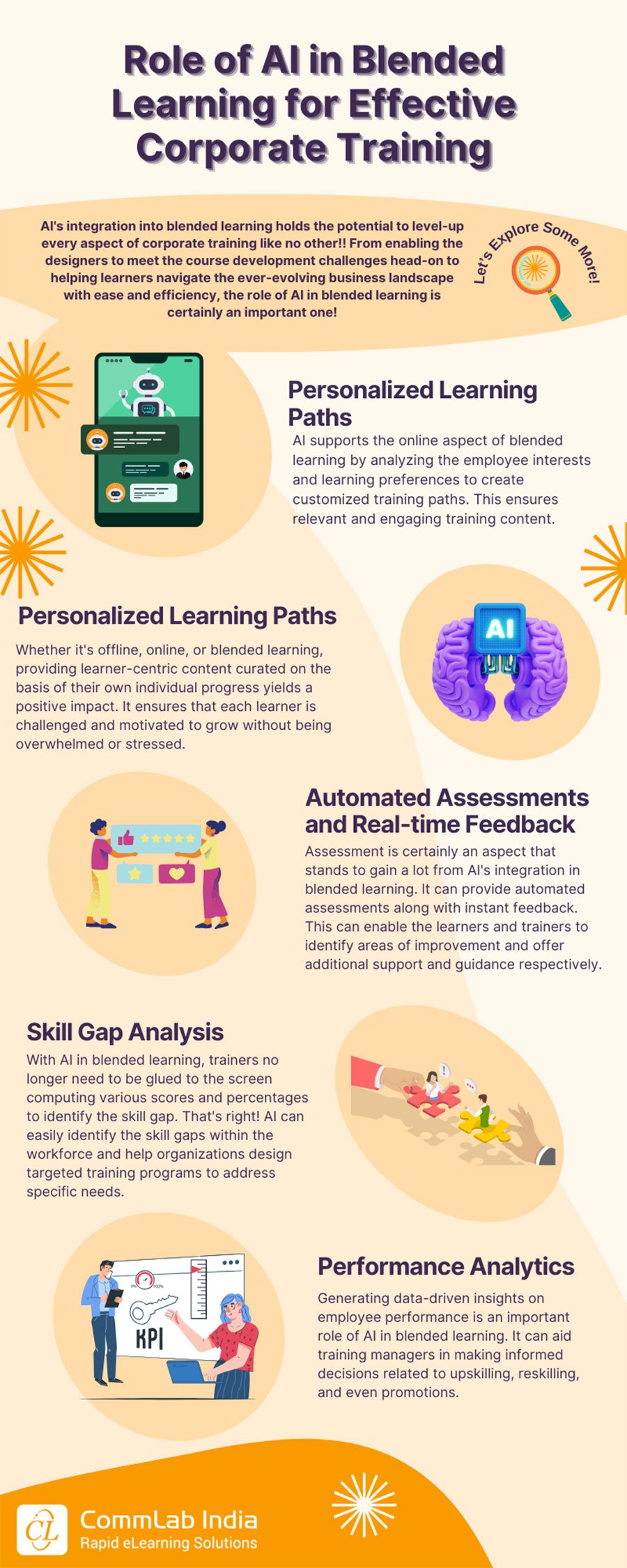Role of AI in Blended Learning for Effective Corporate Training [Infographic]
![Role of AI in Blended Learning for Effective Corporate Training [Infographic] Role of AI in Blended Learning for Effective Corporate Training [Infographic]](https://blog.commlabindia.com/hubfs/blended-learning-ai-role-infographic.jpg)
Artificial intelligence (AI) is making rounds in the corporate world for its efficiency, speed, and scalability. But what about its role in blended learning? Well, blended learning is no exception. AI plays an integral role in ensuring the top-notch, effective, high-quality blended learning programs. That’s right! From facilitating personalized learning to providing data analytics, AI holds the potential to level-up every aspect of blended learning initiatives.
Let’s explore in detail the benefits of blended learning in corporate training, the role of AI in blended learning for effective corporate training, and lastly, the best practices for successful AI-enabled blended learning programs.
Benefits of Blended Learning in Corporate Training
- Provides flexibility in learning
- Promotes collaborative learning
- Caters to different learning styles
- Bids goodbye to scheduling hassles
- Cuts training costs and improves ROI
The Role of AI in Blended Learning for Effective Corporate Training
4 Best Practices for Successful AI-Enabled Blended Learning Programs
Set Clear Learning Objectives and Goals
It’s important to define your learning objectives clearly and align them with overall organizational goals. To put your best foot forward in crafting relevant and effective learning objectives, make sure you conduct a thorough analysis. It’ll help you identify the skills and knowledge that need to be developed through the blended learning program. You can use artificial intelligence (AI) to customize learning pathways and content for each learner. This will augment the relevance and effectiveness of the training program for each learner, thereby maximizing the training ROI.
→ Access Now: Unleashing the Potential of AI in Corporate Training
Use Data Effectively
DATA!! A word whose significance in corporate training (or otherwise) cannot be stressed enough. It’s like a lamp to guide your training programs toward success. You should collect and analyze learner data to understand their preferences, learning styles, interest, etc. Moreover, learning analytics are a great option when it comes to tracking progress, identifying areas for improvement, learner strengths and weaknesses, etc.
Doing all this manually can be both time-consuming and nerve-wracking! And this is where using AI comes in handy. AI plays an integral role in providing data analytics for your blended learning program. It utilizes AI algorithms and predictive analysis to generate insights and recommendations that allow you to create relevant content and activities for desired results. Evidently, AI assists you in making data-driven decisions and continuously optimizing the learning experience.
Create Engaging and Interactive Content
With terms like edutainment being formalized and happily integrated into the corporate training programs, creating engaging and interactive content is basic!! As the hunt for methods to create engaging, immersive learning experiences is always on, leveraging multimedia elements and interactivities hold the fort. Developing interactive and multimedia-rich training courses is essential to capture learners' attention and foster participation.
With that said, AI can help you with this seemingly simple but equally challenging task. You can integrate AI-powered tools into your blended learning program to create animations, videos, simulations, quizzes, etc., for boosting active learning. A variety of content formats enable you to cater to diverse learning styles.
Ensure Continuous Evaluation and Improvement
Whether it is online training or classroom training, continuous evaluation is indispensable. Same goes for AI-supported blended learning too. Make sure you regularly assess the effectiveness of the blended learning program. And to do so, you can start by gathering feedback from learners and instructors. This will help you identify the strong points of the training course and where it needs improvement.
Apart from that, you can leverage data analytics collected by the AI tools to check the areas where learners engaged the most, no. of views per module, assessment scores, completion rates, etc. Based on the results, you can further leverage AI to make adjustments to content, modify delivery methods, and improve training strategies.
Parting Thoughts!
Blended learning is an effective approach to ensure balanced, learner-centric corporate training. It allows you to get the best of both face-to-face interaction and digital learning. Integrating artificial intelligence (AI) significantly widens the scope and efficiency of the blended learning programs. With that said, integrating AI in blended learning requires strategic planning and diligent execution. Now that you’ve learned about the role of AI in blended learning and the best practices, why hold back? Make the best use of AI to reach your set business goals successfully. Check out the webinar below to help you understand and unleash the potential of AI in corporate training.






![Top 5 Blended Learning Formats for Software Training [Infographic]](https://blog.commlabindia.com/hubfs/blogs/Top%205%20Blended%20Learning%20Formats%20for%20Software%20Training.jpg)
